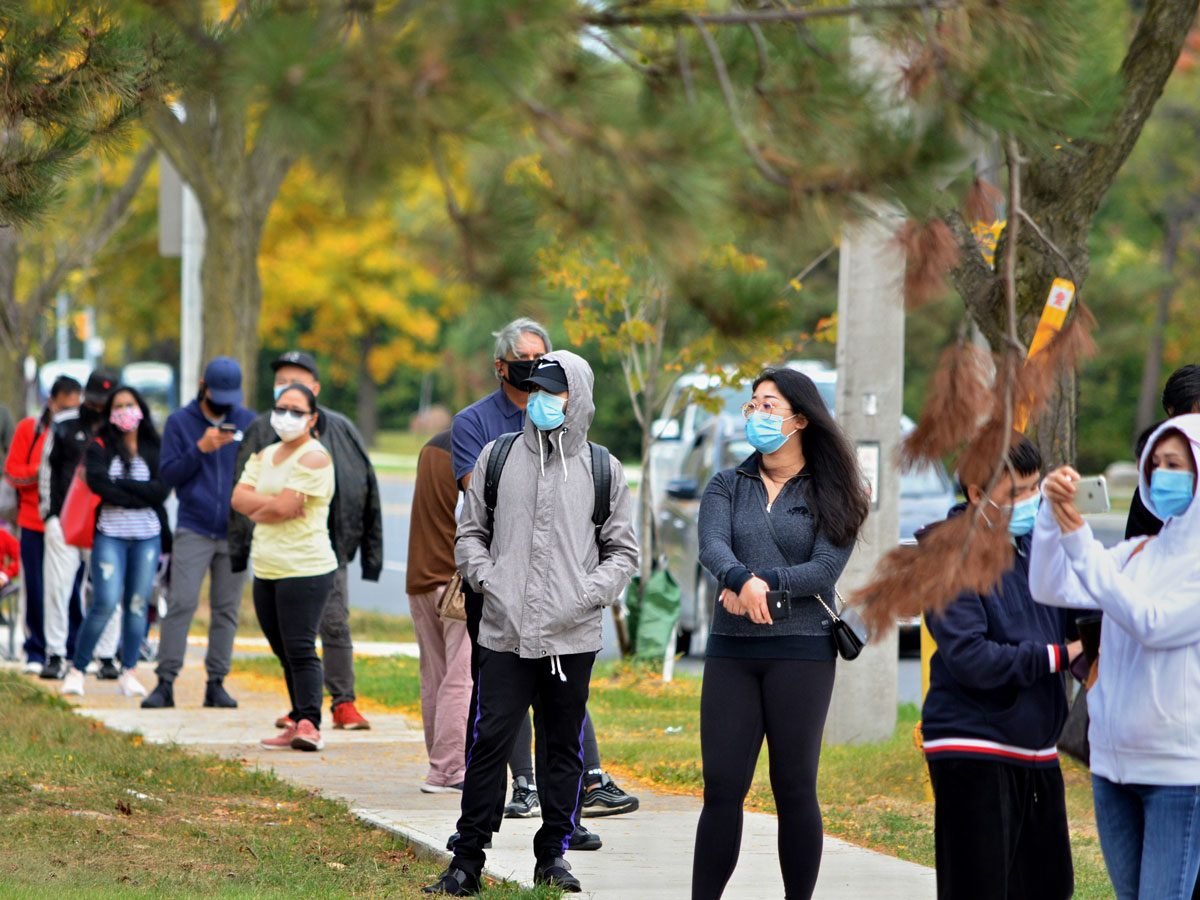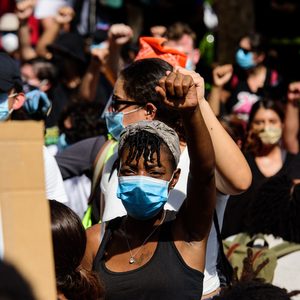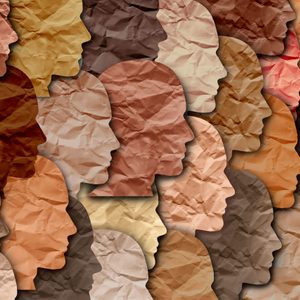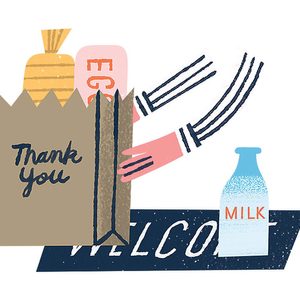As an Asian, I’m Scared of the Pandemic—But Not Because of the Virus
For Asians in Canada, there are two pandemics: the coronavirus and anti-Asian racism. Here’s what we can do to stop the latter.

Two months before the COVID-19 pandemic began shutting down businesses and schools across the country and infecting thousands of Canadians, I was already in a near-constant state of worry. Unlike others, I wasn’t thinking about whether I would lose my job or contract the novel coronavirus. I feared Asians in Canada would be blamed for the impending catastrophe.
With COVID-19 cases in Canada now surpassing 200,000 and a second wave already underway in some provinces, that fear has not disappeared.
Every time I walk to the local supermarket, I now find myself questioning every glance towards me. “Can they tell that I’m Asian?” I ask myself. “If they can, how does that make them feel?” I haven’t been on public transit since March, fearful of getting into an altercation. When my brother or friends offer to hang out, I reply with one condition: “Only if we’re travelling by car.”
As a Canadian of Filipino descent living in Toronto, I’ve never fully believed that Canada is a land of cultural acceptance. While the neighbourhood I’ve lived in for 12 years is a mix of white, East Asian and South Asian residents, I’m no stranger to being the only person of colour in a room full of white people.
For as long as I can remember, I’ve faced seemingly innocuous questions about my country of origin, whether English is my first language, and my cultural values. When people ask me these kinds of questions, what they’re really trying to do is remind me of my “otherness.”
Shining a spotlight on anti-Asian racism
Anti-Asian racism in Canada is nothing new: Chinese immigrants arriving in British Columbia in the 1850s were met with hostility from white residents. The province’s labour leaders eventually lobbied for restrictions on the employment, housing and education of Asian Canadians. Then, during the Second World War, the federal government removed over 22,000 Japanese Canadians—some of whom were Canadian by birth—from their homes and sent them to live in internment camps in British Columbia.
The cruel treatment of Chinese people in Canada during the SARS outbreak in 2003—Chinese students being harassed at school, people of Chinese background being taunted on public transit and widespread mistrust of East Asian communities—is yet another reminder of how far we haven’t come. I was only eight during the SARS outbreak. At the height of the epidemic, my dad underwent an appendectomy at Scarborough General and a SARS-related death at the hospital forced him into quarantine. But while I was aware of the disease’s existence, my parents kept me in the dark about the discrimination Asian-Canadians faced during that period.
As an adult, I’m naturally more aware of the persistent negative perception of East Asians. Days after France confirmed its first coronavirus cases in January, French newspaper Le Courier Picard ran the headline “Le péril jaune?” (Yellow peril?) above an image of a Chinese woman wearing a face mask. Later in March, U.S. president Donald Trump, who continues to downplay the seriousness of the coronavirus, began referring to it as the “Chinese virus.” Then in June, Trump called the virus “Kung flu.”
Times of uncertainty have a way of unleashing racism. When it comes to epidemics, the general public often blames marginalized groups. West Africans were blamed for Ebola in 2014, Mexican-Americans for swine flu in 2009, the Chinese for SARS in 2003 and, even further back in time, Italian immigrants for the 1916 polio epidemic in New York City and Jewish communities for the bubonic plague in the 1300s. Misinformation and fear don’t breed racism, but simply bring to light what has long been embedded in Western culture.
When my worst fears came true
Back in February, I voiced my concerns to only a few colleagues. My parents, meanwhile, had resigned themselves for the inevitable backlash and didn’t linger too long on the subject. I saved my deepest anxieties for my best friend. That unease only increased as news of racist incidents closer to home took over the headlines.
In March, a white man shoved a 92-year-old Asian man outside a convenience store in East Vancouver. According to staff members, the suspect had been shouting racist remarks about COVID-19 at the senior moments before the attack. The suspect was later identified and charged with assault in July.
Then in May, a 40-year-old white man subjected a 15-year-old Asian teen to a racial tirade in a public park in Saskatoon. After the teenager took a picture of the suspect, the man “chased him, [pushed] him off his bike, punched him in his helmet and tackled him.” Police later arrested the man, who appeared in provincial court in August.
And in July in Toronto, a Filipino woman, Justine Abigail Yu, was reading a book on the grounds of a public school when a white woman claiming to be a teacher confronted her. “The woman says there’s signs here that say no trespassing,” Yu recounted in a video posted on her Instagram profile. “[Then she said], ‘Maybe you can’t speak or read English, maybe you should go back to China or go back to wherever it is you’re from.’” The Ontario College of Teachers declined to comment on the investigation, while the Toronto District School Board is currently determining if the woman in question is indeed an employee.
In a recent study from the Angus Reid Institute and the University of Alberta that surveyed more than 500 Canadians of Chinese ethnicity, 50 per cent of respondents reported experiencing insults directly related to the COVID-19 pandemic. Forty-three per cent of those surveyed also said they’ve been threatened or intimidated since the start of the pandemic, while 61 per cent said they’ve adjusted their daily routines in order to avoid potentially racist encounters.
“When the president of the United States calls COVID-19 the ‘Chinese Virus,’ racism becomes legitimate and may even become normalized,” Pamela Sugiman, a sociology professor at Ryerson University, said in an interview with Ryerson Today. “It’s difficult for people to push back because we’re in the midst of a pandemic and everyone is feeling scared and vulnerable.”
How to respond to anti-Asian racism
At the start of the pandemic, Theresa Tam, Canada’s Chief Public Health Officer, wrote on Twitter: “We need to learn from our experience with SARS, where Southeast Asians faced significant racism and discrimination. Racism, discrimination and stigmatizing language are unacceptable and very hurtful. These actions create a divide of ‘Us vs. Them.’”
Underlying each act of anti-Asian racism is the tired notion that Asians are a monolith. We have been reduced to a single identity and experience. If one of us is perceived to have made a mistake, then many may believe we all deserved to be scapegoated.
But we are not a monolith. We come from dozens of countries in Southeast Asia, the Indian Subcontinent and the Far East. As of 2017, there are 1.8-million Chinese people in Canada, with Filipinos accounting for a further 837,000 residents. Some Asians have come to Canada resisting oppression in their native lands. Others have lived in their adopted homes for decades. Some of us have little to no connection to our descendants. We’ve done our best to integrate while also fiercely holding onto our traditional values.
Apathy, however, is the biggest obstacle we face in fighting racism against Asians.
If you are the victim of anti-Asian racism or witness an incident, it’s important to speak up. This present moment in time requires that we support one another and protect victims of hatred. I recommend Fight COVID Racism, a website that features a detailed timeline of anti-Asian incidents in Canada, an incident map, and a form to report racist occurrences.
Just like the Black Lives Matter movement has inspired people of colour around the world to speak out on how they experience race and racism in their own countries, Canadians also need to better educate themselves on our country’s history of anti-Asian racism. Our new normal in Canada consists of face masks, physical distancing and remote work to flatten the COVID-19 curve. We must try to stop anti-Asian racism in its tracks, too.
This story was first published on October 1, 2020.
Next, learn about Caremongering Toronto, the group that inspired thousands of Canadians to help each other through COVID-19.






